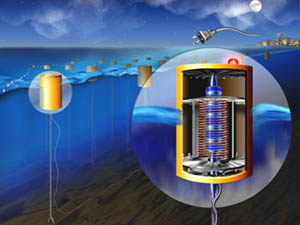Wave Power
Today, power from the waves. The University of Houston's College of Engineering presents this series about the machines that make our civilization run, and the people whose ingenuity created them.
 On the south Oregon coast this fall, I walked the sands and jetties, watching waves erupt upon rocks and piers with gargantuan energy. This was energy unleashed on a scale we don't often see in so raw a form -- out of our hands and running loose.
On the south Oregon coast this fall, I walked the sands and jetties, watching waves erupt upon rocks and piers with gargantuan energy. This was energy unleashed on a scale we don't often see in so raw a form -- out of our hands and running loose.
But we are human, and humans will possess what nature displays. We'll find a way, and here was a prize we all want to claim. Of course the idea of extracting energy from the motions of the sea is old, even if it hasn't been realized very often.
It'd be nice if we could somehow find ways to take energy from those constantly moving waters, and to do it close to our homes on land. We've put our efforts into harnessing tides along our shores. But that's practical only where the tidal rise and fall is large. The Bay of Fundy's 55-foot tidal variation is a major lure. An 18 MW tidal plant already operates on its Nova Scotia shore.
Such places, alas, are few. Tidal power also raises environmental concerns. It has the potential for harming shipping, marine life, and the shore itself. So only a small fraction of our power needs will ever be supplied by tides. Their sister power source, wave energy, on the other hand, begins to look very attractive.
A huge portion of the sun's energy turns into wave motion. And, except for the occasional tsunami, wave energy rides on the ocean's surface -- it rides upon seventy percent of our planet's surface. So: How to get at that energy?
Many wave power systems now lie on drawing boards. Several involve waves filling a tank, then draining out through a turbine. Or waves can fill a tank driving air upward through a flap valve, then through a wind turbine. The air returns to the tank through another valve as the tank drains. And the process repeats.
One system is being installed off the coast of Aguçadoura in northern Portugal: It's Pelamis, a two-and-a-half megawatt floating wave-power-generation farm. Pelamis is a system of four-hundred-foot tanks, with hinges in the middle. They float and flex in the waves, driving hydraulic fluid to power large motor generator sets.
 Another system might, in some near future, ride off that Oregon shore. Engineers at Oregon State University are designing special buoys. They tether a permanent magnet to the sea bottom inside a floating tank. As each wave passes, the tank rises and falls, carrying coils past the magnet. It's a linear electric motor, sending power back to shore through wires on the seabed.
Another system might, in some near future, ride off that Oregon shore. Engineers at Oregon State University are designing special buoys. They tether a permanent magnet to the sea bottom inside a floating tank. As each wave passes, the tank rises and falls, carrying coils past the magnet. It's a linear electric motor, sending power back to shore through wires on the seabed.
OSU electrical engineer Annette von Jouanne describes that one; and she provides a map of good locations for wave power stations. Many lie along the south Atlantic and Indian Oceans, as well as the Atlantic coasts of Europe and England.
Our Pacific Northwest coast is especially good. Within the excitement and theater of crashing waves there on the Oregon coast, I was indeed seeing a rich source of power -- ripe for harvesting.
I'm John Lienhard, at the University of Houston, where we're interested in the way inventive minds work.
For more on tidal power see Episode 1654.
A. von Jouanne, Harvesting the Waves. Mechanical Engineering, Vol. 128, No. 12, Dec. 2006, pp. 24-27.
The linear motor illustration is from the Annette von Jouanne's article. Wave photos by JHL.

Waves near Bandon, Oregon